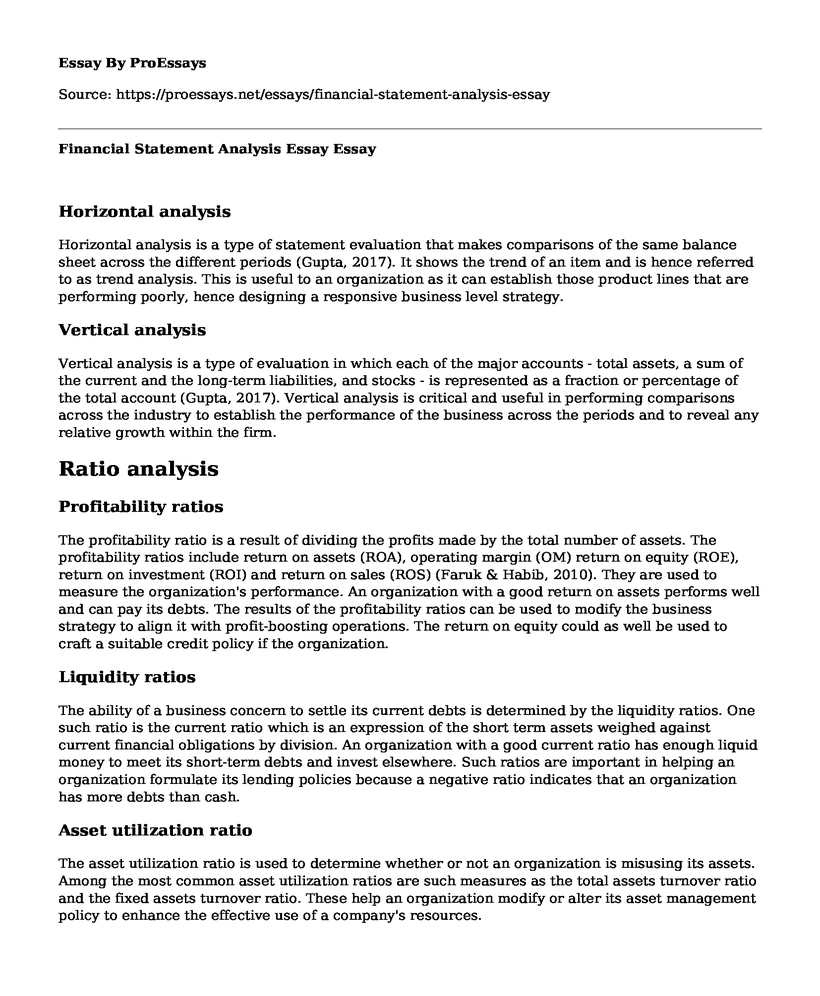Horizontal analysis
Horizontal analysis is a type of statement evaluation that makes comparisons of the same balance sheet across the different periods (Gupta, 2017). It shows the trend of an item and is hence referred to as trend analysis. This is useful to an organization as it can establish those product lines that are performing poorly, hence designing a responsive business level strategy.
Vertical analysis
Vertical analysis is a type of evaluation in which each of the major accounts - total assets, a sum of the current and the long-term liabilities, and stocks - is represented as a fraction or percentage of the total account (Gupta, 2017). Vertical analysis is critical and useful in performing comparisons across the industry to establish the performance of the business across the periods and to reveal any relative growth within the firm.
Ratio analysis
Profitability ratios
The profitability ratio is a result of dividing the profits made by the total number of assets. The profitability ratios include return on assets (ROA), operating margin (OM) return on equity (ROE), return on investment (ROI) and return on sales (ROS) (Faruk & Habib, 2010). They are used to measure the organization's performance. An organization with a good return on assets performs well and can pay its debts. The results of the profitability ratios can be used to modify the business strategy to align it with profit-boosting operations. The return on equity could as well be used to craft a suitable credit policy if the organization.
Liquidity ratios
The ability of a business concern to settle its current debts is determined by the liquidity ratios. One such ratio is the current ratio which is an expression of the short term assets weighed against current financial obligations by division. An organization with a good current ratio has enough liquid money to meet its short-term debts and invest elsewhere. Such ratios are important in helping an organization formulate its lending policies because a negative ratio indicates that an organization has more debts than cash.
Asset utilization ratio
The asset utilization ratio is used to determine whether or not an organization is misusing its assets. Among the most common asset utilization ratios are such measures as the total assets turnover ratio and the fixed assets turnover ratio. These help an organization modify or alter its asset management policy to enhance the effective use of a company's resources.
Debt utilization ratio
The debt utilization ratio, also referred to as the credit utilization ratio refers to the amount of credit that is currently in use. A company with less than 30 percent credit in use would be ranked highly by the credit reporting bodies. This ratio helps lenders make policies regulating lending to institutions, organizations and small businesses.
Benchmarking
Benchmarking refers to the practice of an organization seeks to survey and learn from the best practices of the leading performers in the industry (Elmuti & Kathawala, 1997). If organization X is the best performer by certain metrics, Company Z, which performs dismally would want to learn the best practices from the industry leaders. Benchmarking helps an organization to re-structure its policies in line with the industry leader's practices for better performance.
References
Elmuti, D., & Kathawala, Y. (1997). An overview of benchmarking process: a tool for continuous improvement and competitive advantage. Benchmarking for Quality Management & Technology, 4(4), 229-243.
Faruk, H., & Habib, A. (2010). Performance evaluation and ratio analysis of Pharmaceutical Company in Bangladesh. Retrieved on April 27, 2018 from http://hv.diva-portal.org/smash/get/diva2:323754/FULLTEXT01.pdf
Gupta, D. A. (2017). Emerging Importance of Financial Statement Analysis. Accents International Journal of Multidisciplinary Study, 1(1).
Cite this page
Financial Statement Analysis Essay. (2022, May 17). Retrieved from https://proessays.net/essays/financial-statement-analysis-essay
If you are the original author of this essay and no longer wish to have it published on the ProEssays website, please click below to request its removal:
- Overview of Nigerian Economy Up to 2017 Paper Example
- Organizational Changes on Samsung and Apple Example
- Research Paper on Banking Sector and Development of Corporate Governance in Mauritius
- Essay Sample on Gucci's "Blackface" Incident
- Research Paper on Globalization & Tax Evasion: Negative Consequences for States
- Keynesian Perspective: AD/AS Model & Recessionary Gap - Essay Sample
- Code of Ethics: Global Benchmark for Investment Specialists - Essay Sample







